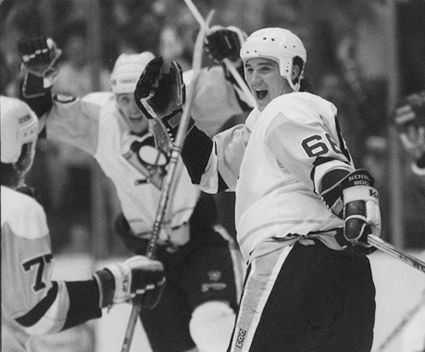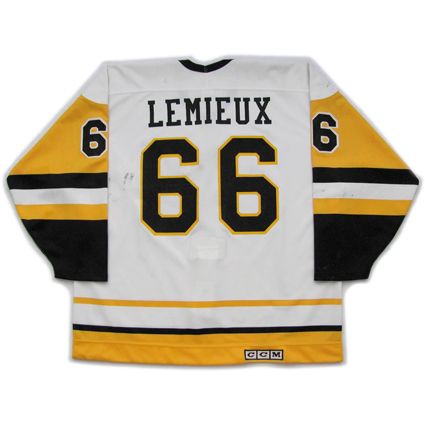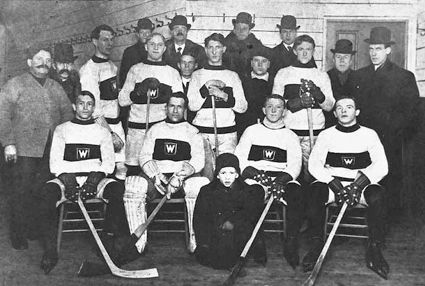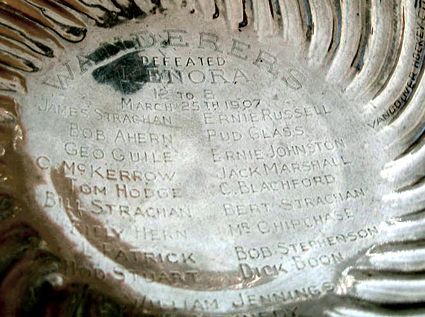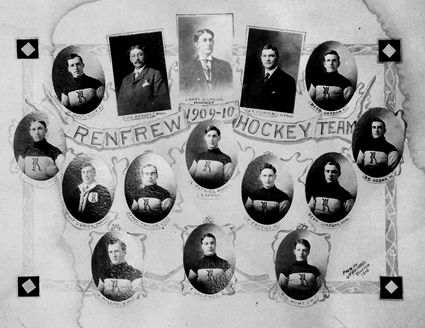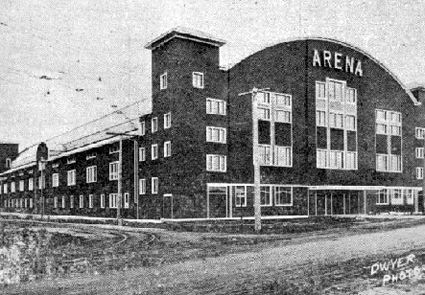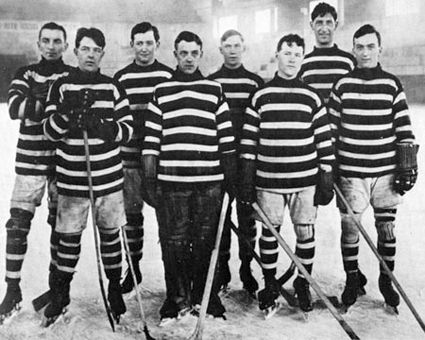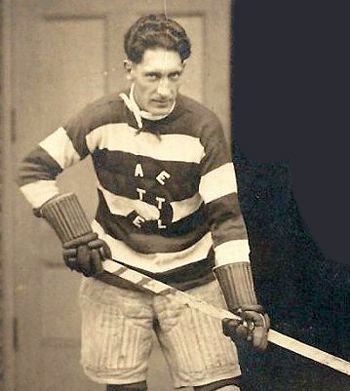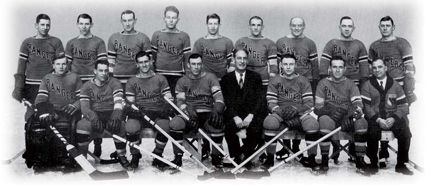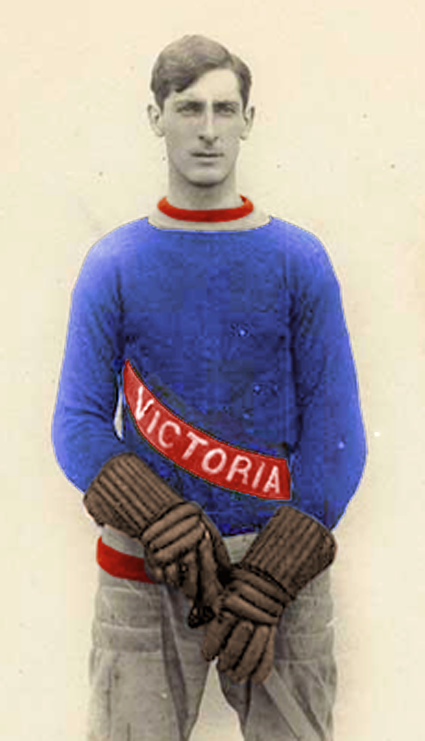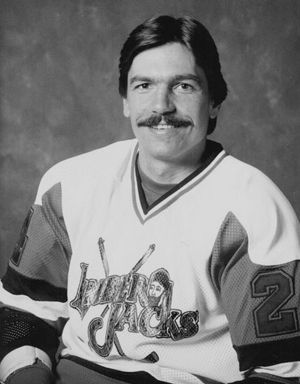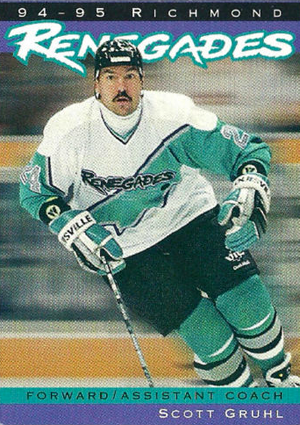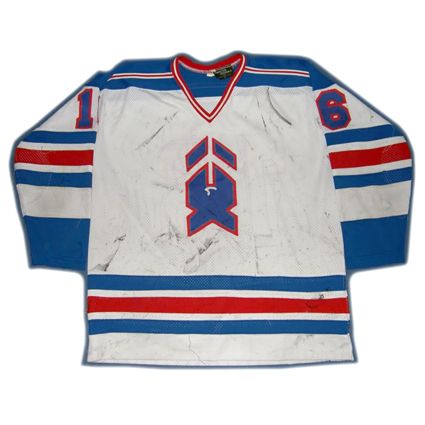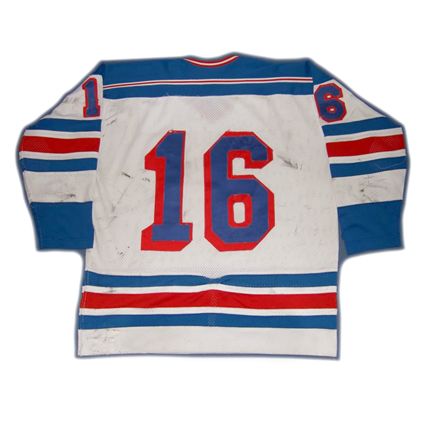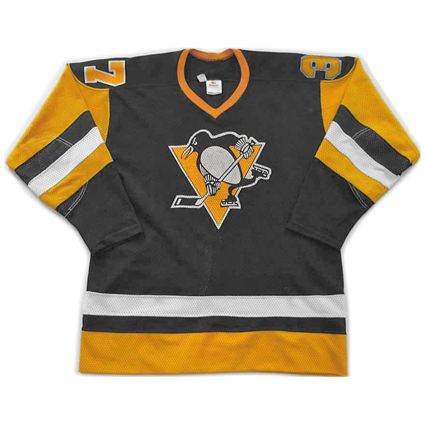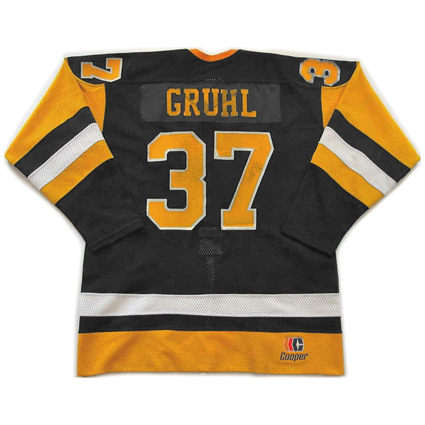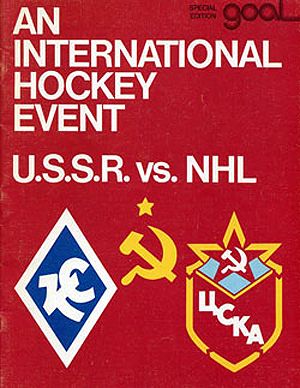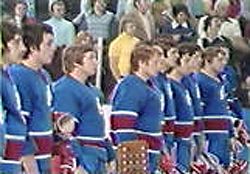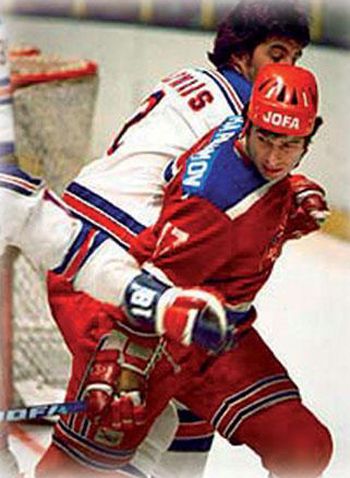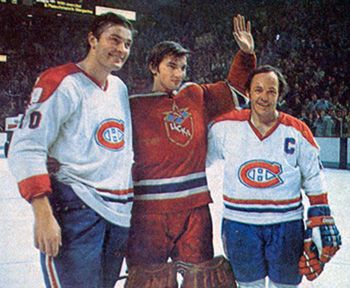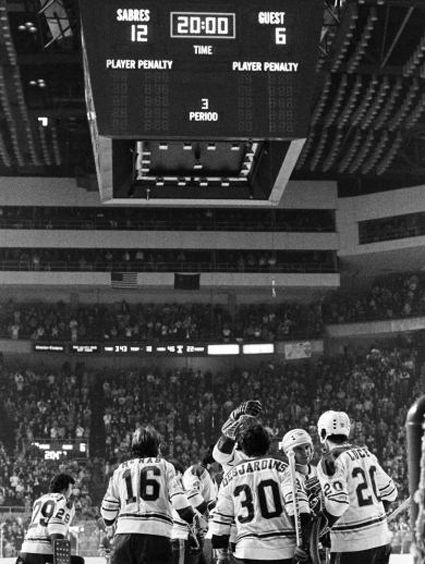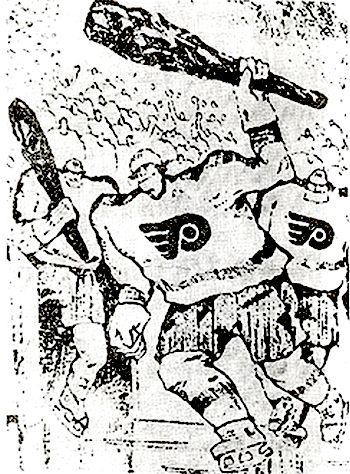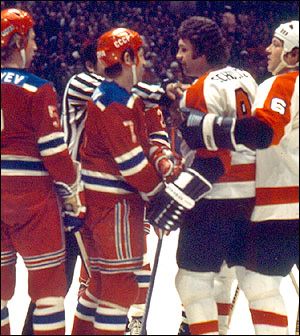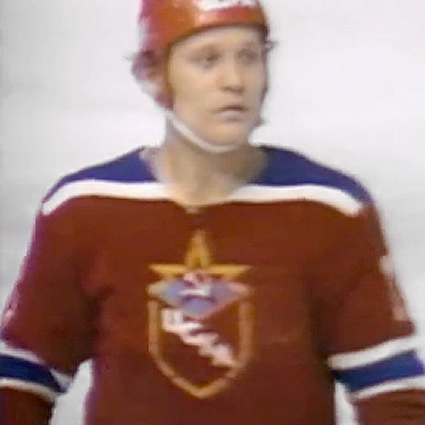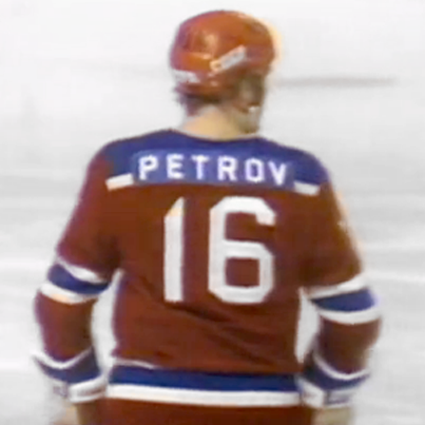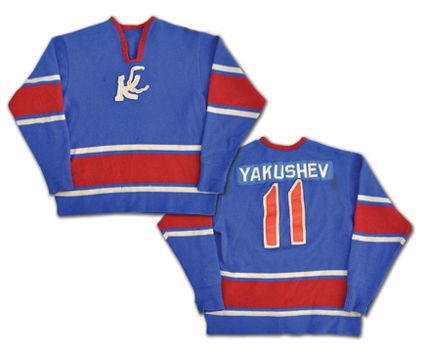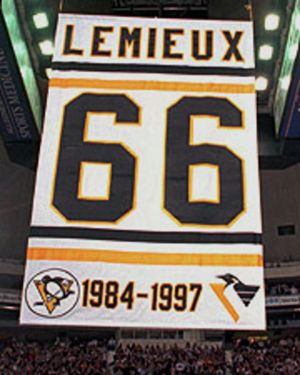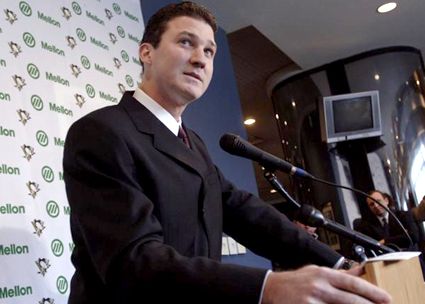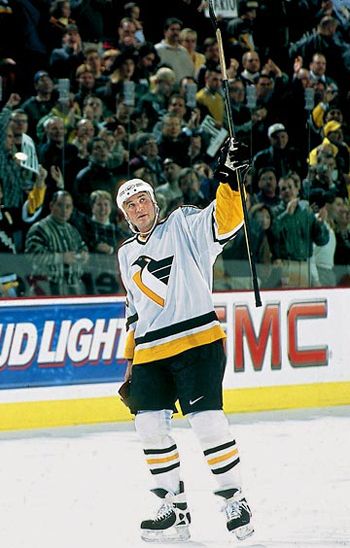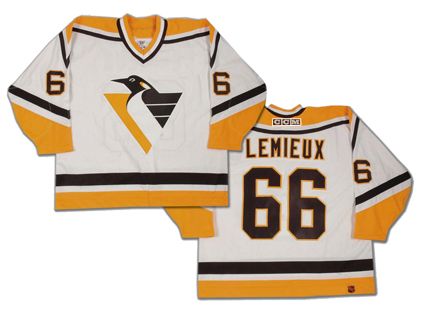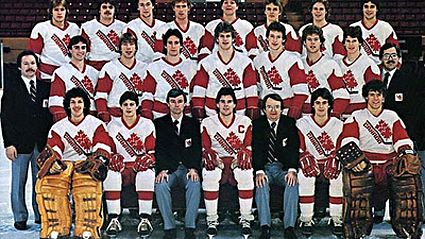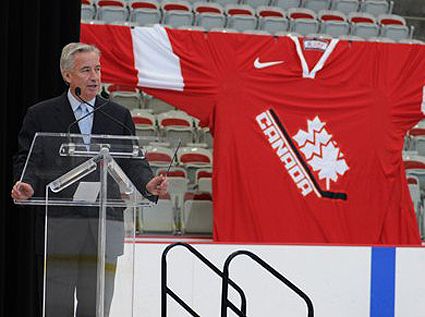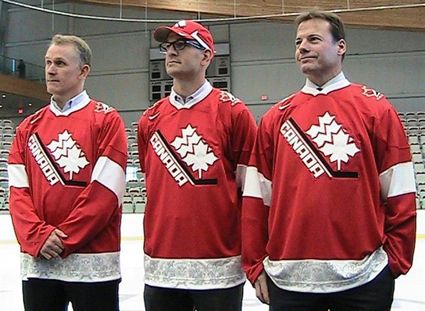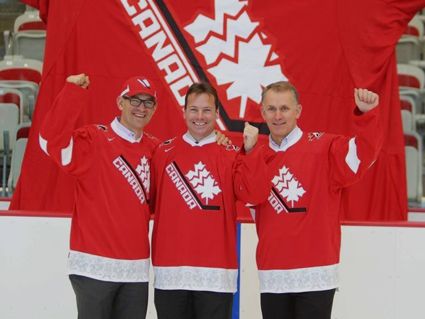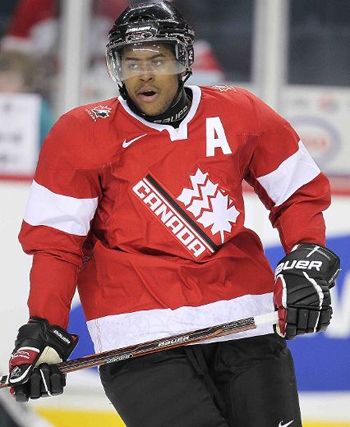Saturday, December 31, 2011
1988-89 Pittsburgh Penguins Mario Lemieux Jersey
In one of the most miraculous nights in NHL history, on this date, New Year's Eve in 1988, Mario Lemeiux of the Pittsburgh Penguins scored five goals - in five different ways!
Their opponents that night were the New Jersey Devils and Lemieux began is night in typical Lemieux fashion, skating down the right side and scoring an even strength goal at 4:17 of the first period to tie the score at 1-1.
His next goal came shorthanded, undressing Aaron Broten and deking Devils goaltender Bob Sauve for a goal at 7:50 with the Penguins a man down.
He was then set up on a power play by Paul Coffey at 9:46 with the Devils two men short, firing a one-timer for the hat trick, all in the first period.
With the Penguins being awarded a penalty shot after the second Devils goaltender of the game, Chris Terreri, threw his stick at the puck while in Lemieux's posession, Lemieux was naturally chosen to take the shot. He converted through Tererri's legs for his fourth of the game at 11:14 of the second, making him three for three in his career penalty shots at the time.
He concluded his magical evening with an empty net goal at 19:59 of the third, giving him five goals in five different ways, something likely to never be repeated any time soon, if ever.
Teammates celebrate Lemieux's spectacular performance
His fifth goal sealed the Penguins victory by a final score of 8-6 as Lemieux completed his eight point night, as he had already assisted on the three goals he didn't score!
Today's featured jersey is a 1988-89 Pittsburgh Penguins Mario Lemieux jersey worn on the memorable night during which he scored 8 points on 3 assists and 5 goals, each scored a different way - regular strength, shorthanded, power play, penalty shot and open net!
This is the first and only year for this particular variation of the Penguins jersey, as the previous season the white sweaters had a gold collar for one season and the numbers were still located up on the shoulders. For 1988-89, the collar changed back to black and the numbers were moved down onto the sleeves, now contained inside the yellow area.
Soon afterwards this style Penguins jersey would undergo it's final changes, with the names on the back now being a sans-serif block font. In addition, the font for the numbers would change slightly, to a thicker font for the back numbers and the sleeve numbers getting noticeably more squarish when compared to the previous style.
Here they are, all five goals in five different ways, on New Year's Eve in 1988.
Labels:
Lemieux Mario,
Pittsburgh Penguins
Friday, December 30, 2011
1913-14 Victoria Aristocrats Lester Patrick Jersey
Hockey icon and legend Lester Patrick was born on this date in 1883 in Dummondville, Quebec. After playing at McGill University he starred for Brandon Wheat Cities, who challenged the mighty Ottawa Senators in March of 1904 for the Stanley Cup. It was there that Patrick became acknowledged as the first defenseman to ever score a goal. After playing one season with Westmount Academy in 1905, Patrick signed on to play with the Montreal Wanderers for the 1906 season.
The Wanderers finished second to the Senators during the regular season, but prevailed in the playoffs by dominating the first game of their two-game, total goals series 9-1, and held on for dear life in still one of the most dramatic games in Stanley Cup history when they added an early goal to go up 10-1 in the series only to see Ottawa storm back with nine consecutive goals to tie the series at 10-10. Then, with just a minute and a half left to play, Patrick would score to regain the series lead for the Wanderers and then ice the series with another goal just before the end of the game to not only give the Wanderers the Stanley Cup, but end Ottawa's three year stranglehold on the cup.
The Stanley Cup champion 1906 Montreal Wanderers
After losing the cup to the Kenora Thistles in January of 1907, the Wanderers and team captain Patrick won the Eastern Canada Amateur Hockey Association league title, which earned them the right to a rematch with the Thistles, which they were able to win thanks to a five goal margin after their 7-2 win in Game 1 of their two game, total goals series, as second game went to Kenora 6-5.
Of note, afterwards, the Wanderers brought the cup with them to have a photo taken to commemorate their success, but forgot to take it with them when the photo session was over. The photographer's mother took a liking to her new found silver bowl and decided it would make a wonderful planter and filled it with dirt and geraniums for several months until the Wanderers remembered where they have left it and reclaimed it for its original intended purpose!
Of note, afterwards, the Wanderers brought the cup with them to have a photo taken to commemorate their success, but forgot to take it with them when the photo session was over. The photographer's mother took a liking to her new found silver bowl and decided it would make a wonderful planter and filled it with dirt and geraniums for several months until the Wanderers remembered where they have left it and reclaimed it for its original intended purpose!
The Stanley Cup champion 1907 Montreal Wanderers
The Wanderers also began a tradition with their 1907 victory, as they became the first team to engrave each players name into the cup to commemorate their victory, something which would not become an annual happening until 1924.
The 1907 Wanderers roster engraving
With his father Joe Patrick moving the family west to pursue new business interests, Lester sat out the 1908 season and played sporadically in 1909. He returned to organized hockey in 1910 when industrialist Ambrose O'Brien formed the National Hockey Association and brought in the best of the best in an effort to bring the Stanley Cup to his hometown of Renfrew. O'Brien lavished extravagant contracts to Cyclone Taylor, Newsy Lalonde, Lester as well as his brother Frank Patrick, who were all only too happy to accept O'Brien's money.
Such was the amount of money, a record $5,250 to Taylor and $3,000 each for the Patricks for a two-month, 12 game season, the Creamery Kings were dubbed the "Millionaires" by the press. Alas, the club came in third behind the Wanderers and Senators and failed to reach their goal of the Stanley Cup.
Such was the amount of money, a record $5,250 to Taylor and $3,000 each for the Patricks for a two-month, 12 game season, the Creamery Kings were dubbed the "Millionaires" by the press. Alas, the club came in third behind the Wanderers and Senators and failed to reach their goal of the Stanley Cup.
The 1909-10 Renfrew Millionaires
The Patrick brothers returned to the west, now joining the family who had moved from Nelson, British Columbia 400 miles further away to Vancouver where they put into motion their plans to form their own league, which included constructing their own arenas, some of the earliest capable of making artificial ice, thanks to their father's financing from profits from his successful lumber business.
Patrick Arena in Victoria, BC
The Pacific Coast Hockey Association was launched in 1912 with three clubs, Frank's Vancouver Millionaires, the New Westminster Royals and Lester's Victoria Senators, for whom Lester was a player, captain, coach, general manager and owner!
The 1912 Victoria Senators - note the 6' 1" Patrick in the back row
Running their own league game the Patricks the freedom to institute new rules, as they were constantly thinking of new ideas to improve the game of hockey, including numbered sweaters, blue lines, penalty shots, credit for assists, changing players on the fly and allowing goaltenders to leave their feet in order to make a save among other innovations.
Lester would play for Victoria, renamed the Aristocrats for 1913-14, for six seasons until the franchise relocated to Spokane, Washington for 1916-17 due to the Canadian military occupying their arena due to World War I. The franchise only lasted one season in Spokane, which led to Lester joining the Seattle Metropolitans for the 1917-18 season.
Lester Patrick with the Seattle Metropolitans
The Aristocrats were revived in time for the 1918-19 campaign, bringing Lester back to Victoria for four more seasons on the ice, which saw his games played dwindle from 11 to 5 to just 2 in 1921-22 before finally retiring from playing in order to concentrate on solely running the club.
With both the Millionaires and Metropolitans from the PCHA having won the Stanley Cup (Vancouver in 1915 and Seattle in 1917), 1925 finally saw Victoria rise to the top of the hockey world as they defeated the Montreal Canadiens of the NHL three games to one.
Lester Patrick's Stanley Cup champion 1924-25 Victoria Cougars
Patrick did return to the ice for one final season in 1925-26, but then retired as a player once again. Despite the success of Victoria, by this time the PCHA was no more, as the size of the crowds were insufficient to support a professional league and the circuit had already been merged with the Western Canada Hockey League in an attempt to survive. After one additional season, the Patricks saw the writing on the wall and stuck a deal to sell their players to the NHL, which used the Cougars roster to stock the expansion NHL franchise in Detroit, which was first named the Cougars in honor of the Victoria club which had supplied them with their roster.
Lester then moved east, and took a position with the upstart New York Rangers as their coach and general manager.
No story of Patrick would be compete without mentioning the famous incident in the 1928 Stanley Cup Finals when starting Rangers goaltender Lorne Chabot took a puck to the eye and could not continue. When the Montreal Maroons refused the Rangers request to use the Senators Alex Connell as a replacement, Patrick donned the pads himself at the age of 44, making "The Silver Fox" the oldest goaltender in playoff history, a mark which still stands today. The Rangers stood tall in front of their coach, forcing the Maroons to shoot from as far away as possible. Although Lester allowed one goal, the Rangers not only won the game in overtime, but they went on to win the Stanley Cup in only their second season of play, albeit with an acceptable substitute in goal for the remainder of the series!
Patrick as the Rangers emergency goaltender in the 1928 Stanley Cup Finals
The Rangers won the title again in 1933, a season which also saw Patrick named club president.
The Stanley Cup champion 1932-33 New York Rangers
Lynn, Lester and Muzz Patrick
Frank later stepped down as coach to focus on his general manager duties, overseeing another Stanley Cup championship in 1940, which saw all three Patricks have their names added to the cup, a tradition which dates back to father Lester's Wanderers.
Lester Patrick tries on the Stanley Cup for size in 1940
Following his departure from the Rangers in 1950, he returned to Victoria, where he oversaw the WHL's Victoria Cougars until his retirement in 1954.
He was inducted into the Hockey Hall of Fame in 1947. In 1966 the Lester Patrick Trophy was first awarded for outstanding service to hockey in the United States and in 1974, the Patrick Division of the NHL was named in his honor.
Today's featured jersey is a 1913-14 Victoria Aristocrats Lester Patrick jersey. This sweater was adopted for the franchise's second season after using a barberpole style for the inaugural 1912 season.
Our video section today begins with a look at the Patrick family and their role in the history of hockey.
Next, a look at the 1933 champion New York Rangers, which includes and interview with "their famous coach" Lester Patrick.
Labels:
Patrick Lester,
Victoria Aristocrats
Thursday, December 29, 2011
1981-82 New Haven Nighthawks Scott Gruhl jersey
Left winger Scott Gruhl first played two seasons at Northeastern University where he started off slowly with 6 goals and 10 points in 17 games in 1976-77. The following season he led the Huskies in scoring with 21 goals and 59 points in 28 games, an average of over two points per game.
Undrafted, Gruhl played Canadian junior hockey in 1978-79 for the Sudbury Wolves, racking up 35 goals and 84 points in 68 games. He turned professional in 1979-80 when he began his lengthy International Hockey League career with the Saginaw Gears. He led the Gears in scoring with 53 goals and 93 points in 75 games. A second season in Saginaw saw a virtually identical result, with 56 goals and 90 points. 19 points in 13 games followed in the postseason, a the Gears captured the Turner Cup with a sweep of the Kalamazoo Wings.
Now part of the Los Angeles Kings organization, Gruhl was assigned to the New Haven Nighthawks of the American Hockey League for two seasons, during which he scored 28 and 25 goals, as well as making his much hoped for NHL debut. Called up by the Kings, Gruhl played in 7 games in 1981-82, which included scoring his first NHL goal, as he registered a pair of goals and an assist. 1982-83 saw him also see action in 7 games, during which he scored two assists.
It was back to Michigan and the IHL for the 1983-84 season, as Gruhl joined the Muskegon Mohawks, who he led in scoring with 40 goals and 96 points. The franchise changed it's name to the Muskegon Lumberjacks for the 1984-85 season, as Gruhl had a career year, scoring 62 goals and 64 assists for 126 points, all career bests. He placed second in the league scoring race and was named the IHL's MVP.
The Lumberjacks would make it all the way to the Turner Cup Finals, beginning a period of success that would see them play in the finals six times in eight seasons.
Despite his stellar offensive season, no NHL opportunities were forthcoming for 1985-86, and Gruhl once more suited up for the Lumberjacks, for whom he scored another 59 goals and 109 points. During the postseason, Gruhl had 20 points in 14 games as Muskegon won the Turner Cup with a sweep of the Fort Wayne Komets.
Two more seasons with the Lumberjacks saw Gruhl add 34 goals followed by 28 in 1987-88, a season during which he made his awaited return to the NHL, this time with the Pittsburgh Penguins for six games during which he scored one goal.
Back in Muskegon in 1988-89 and 1989-90 back to back 92 point seasons saw Gruhl score 37 and then 41 goals, as well as two more Turner Cup Finals appearances, winning the championship in 1989 while contributing 19 points in 14 playoff games.
After seven seasons in Muskegon, Gruhl remained in the IHL, only now with the Komets. He brought not only his prodigious offensive skills, but his knack for playoff success as well, for during his first season in Fort Wayne, he extended his streak of 20 goals seasons to 12 as the Komets made it to the Turner Cup Finals.
During his second season in Fort Wayne, he scored 44 goals and 105 points to lead the Komets in scoring. Another 34 goals arrived in 1992-93, two of which he scored on this date in 1992 against the San Diego Gulls, giving him 551 and 552 to become the IHL's all-time leading goal scorer, breaking the record held by Joe Kastelic.
Gruhl added 15 points in 12 playoff games as Fort Wayne won the Turner Cup, the fourth for Gruhl in his career. For the 1993-94 season, he spilt his time between the Milwaukee Admirals and Kalamazoo, scoring a combined 21 goals to extend his 20 goals or more streak.
The Richmond Renegades of the ECHL was the next stop for Gruhl, leading the team in scoring in 1994-95 with 31 goals and 71 points. 17 playoff games and 18 points later, Gruhl was once again a champion, as the Renegades defeated Greensboro for the Kelly Cup, the fifth championship of Gruhl's career.
His final season in professional hockey saw him lead the Renegades in scoring yet again, this time with 46 goals, which meant for his entire 17 year professional career, Gruhl scored at least 20 goals, a testament to not only his scoring abilities, but his durability as well, as he never played less than 49 games in a season and 16 seasons of 55 or more, 9 of which were over 70 games played.
Upon his retirement, Gruhl held the IHL career goal scoring record for regular season and playoffs combined. His final regular season IHL total was 532, and with his 54 AHL, 77 ECHL and 3 NHL goals added together, his professional tally was 666.
Today's featured jersey is a 1981-82 New Haven Nighthawks Scott Gruhl jersey. Done in the colors of their parent club at the time, the New York Rangers, this Nighthawks jersey features a very stylized crest, which may actually contain a hawk somewhere inside of it.
The Nighthawks were founded back in 1972 and played with the Nighthawks name until 1991-92 before changing their name to the Senators for one season prior to relocating from Connecticut to Prince Edward Island and later Binghamton, New York, where they are still known as the Senators.
Note the somewhat haphazard customization of the jersey, particularly the red drop shadow on the 6, which not only goes correctly down and to the left, but also to the right as well!
Bonus Jersey: Today's bonus jersey is a 1987-88 Pittsburgh Penguins Scott Gruhl jersey worn during his six games with the Penguins in 1987-88, the final NHL action of his career.
The Penguins changed from their previous navy blue jerseys to black and yellow during the 1979-80 season to match the colors worn by Pittsburgh's two other major league clubs, the Pittsburgh Pirates of major league baseball and the Pittsburgh Steelers of the NFL, both of whom had won championships in 1979.
The Penguins wore this basic style all the way until 1991-92, closing out it's run with back-to-back Stanley Cup championships. The jerseys did pass through several periods of detail changes, such as the placement of the sleeve numbers, angle of the sleeve stripes, heat sealed customizing, later replaced by sewn on twill, changes in font for the names, which included two color names, one color names, letters with serifs and letters without and finally a change in font for the numbers as well.
Feel the excitement at the Muskegon Lumberjacks win the 1986 Turner Cup and team captain Scott Gruhl accepts the Turner Cup.
In this next clip, Dave Michayluk scores late in a game against Sokol Kiev from the Soviet Union on an assist from Gruhl while the Lumberjacks were wearing their Pittsburgh Penguins inspired jerseys.
Gruhl's career is one of two dozen documented in "Journeymen: 24 Bittersweet Tales of Short Major League Sports Careers".
Wednesday, December 28, 2011
1975-76 Soviet Central Red Army Vladimir Petrov Jersey
A new era in NHL history began on this day in 1975, when the New York Rangers hosted the HC CSKA Moscow, more popularly known as Central Red Army, the most dominant club in the history of the Soviet Championship League.
Prior to this point, the Soviet National Team had competed against the Team Canada in the Summit Series in 1972 and again in 1974 versus a team made of WHA All-Stars.
Wanting to further capitalize on the success of the Summit Series, and the capital to be gained from the mystery and curiosity surrounding the still exotic Soviets from behind the Iron Curtain, the Super Series '76 was scheduled. What set the Super Series '76 apart from the previous competitions was this was the first time that club teams from the Soviet Union would be facing teams from the NHL.
Goal magazine program cover for the 1976 Super Series
While some motivation for the series was certainly profit oriented, neither side wanted to be humbled or worse, humiliated, with the eyes of the hockey world upon them. Already armed with the Red Army club, the other team making the trip over to North America was the defending Soviet champions, Krylya Sovetov Moscow, better known to North Americans as the Soviet Wings, due to their position as the sporting club of the Soviet Air Force. To ensure the strongest clubs possible, the Red Army team was augmented with a pair of players from Dynamo Moscow and the Wings added four members of Spartak Moscow to enhance their roster.
Representing the NHL were the New York Rangers, Montreal Canadiens, Boston Bruins, Philadelphia Flyers, Pittsburgh Penguins, Buffalo Sabres, Chicago Black Hawks and New York Islanders. While the NHL participants were all located in the east, they also represented some of the strongest clubs in the NHL at the time, with the Flyers having won the Stanley Cup the previous season over the Sabres, while the Islanders and the Canadiens were semifinalists and all of the clubs had qualified for the playoffs in 1974-75.
Despite all the games taking place in the east, don't overlook the absence of both the Detroit Red Wings (58 points the previous season compared to the 113 totaled by the Flyers, Sabres and Canadiens) and the dreadful expansion Washington Capitals, who finished the previous season at 8-67-5 for 21 points, and whom the NHL was not going to let anywhere near the best of the Soviet Union. The Toronto Maple Leafs, on the other hand, were absent due to cantankerous owner Harold Ballard's refusal to allow Soviet teams to play in Maple Leaf Gardens!
The Super Series '76 first game was held on this date in 1975 when the Red Army club invaded Madison Square Garden to take on the Rangers, who were led by Rod Gilbert, Steve Vickers, Rick Middleton, Carol Vadnais and known patriot Phil Esposito, who would skate through a brick wall to uphold the honor of the NHL against the Soviets.
The Red Army club, meanwhile, was the de facto Soviet National Team, and was led by Vladimir Petrov, Boris Mikhailov, Valeri Kharlamov and goaltender Vladislav Tretiak.
Tretiak tending goal for Central Red Army
The Red Army prevailed on that night with a dominant 7-3 victory in front of 17,500 Rangers fans. Similar to the start of the 1972 Summit Series, the North Americans scored quickly, this time just 21 seconds into the game on a goal by Vickers. Unfazed, the goal did nothing more than wake the sleeping bear, and Red Army had the lead four minutes later and led 3-1 after the first. The Soviets kept piling it on until their lead had stretched to 7-1 at one point before the Rangers were able to put two meaningless goals by Tretiak to make the final 7-3, the exact same score of Game 1 of the first Summit Series. Petrov scored four points on 2 goals and 2 assists while Kharmalov had a goal and 3 assists to lead Red Army, who were outshot 41-29.
Carol Vadnais of the Rangers defends Valeri Kharlamov
A near equal result followed the next day when the Soviet Wings easily handled Pittsburgh 7-4.
The next game for the Red Army came in Montreal on New Year's Eve, the now legendary game between two of the finest clubs ever, both in mid-season form, as the eventual 1975 champion Canadiens, who were on the verge of a dynasty, skated to a 3-3 tie with the Soviets in what many call the greatest game ever played, as Tretiak held off the NHLers despite being outshot 38-13.
The three stars of the fabled New Year's Eve game, Peter Mahovlich, Tretiak and Yvan Cournoyer
Next up for the Wings was a trip to Buffalo on January 4, 1976, a night those in attendance will never forget, as the Sabres pounded the Wings 12-6, earning the distinction of becoming the first NHL club to ever defeat a Soviet club.
It would be the worst loss ever by a Soviet team in international competition. So popular was the Sabres win with NHL fans that they received a standing ovation before their next game - in Montreal!
Sabres general manager Punch Imlauch called the game "was the all-time high point for the Sabres"as well as the highlight of his lengthy career.
Such was the significance of the Sabres victory that a souvenir of a game is created following the contest
"I had never been so fired up for a game," said Rick Martin. "I had played in a lot of big games, but that truly was the game I'll never forget."
The Wings rebounded from their crushing defeat by Buffalo to down the Chicago Black Hawks three days later 4-2, while the Red Army stayed unbeaten with a 5-2 win in Boston on January 8th.
The Wings then concluded their North American foray with a 3-1 record after their 2-1 defeat of the New York Islanders, but the Red Army still had one battle awaiting them in the form of the Broad Street Bullies in Philadelphia.
Played on January 11th, the two-time defending champions were also eager to defend the honor of North American hockey - by any means necessary. Fired up by club owner Ed Snider, the Flyers were out to prove they were the best club hockey team on the planet.
The Flyers reputation preceded them, and the Soviets were already aware of the Bullies style, especially in the form of captain Bobby Clarke, whose previous encounter in the 1972 Summit Series with Kharlamov had resulted in a broken ankle for the Soviet legend at the hands of Clarke.
A cartoon in a Soviet newspaper depicting
the Flyers with clubs instead of sticks
The Flyers held the Soviets scoreless after one period, taking the body whenever possible to attempt to contain the Red Army's uptempo style. The game proved to be a contentious one, with many scrums and hard hits.
Dave Schultz welcomes the Soviets to the City of Brotherly Love
The most notable event of the night was when the Flyers Ed Van Impe returned to the ice following a penalty, demolished Kharlamov, who stayed on the ice for a minute. When no penalty was called, the coach of Red Army, Konstantin Loktev, pulled his club off the ice in protest. A shouting match ensued between Snider and the president of the Soviet Hockey Federation, with Snider threatening to withhold payment to the Soviets.
Eventually Red Army relented, and returned to the ice, with the Flyers now even more intent on winning, and doing it their way, more than ever. It would take Philadelphia 17 seconds to score on the ensuing power play which resulted from the delay of game penalty imposed on the Soviets for their 16 minutes off the ice. A second Flyers goal ended the first period 2-0.
With the Flyers shorthanded once again, they opted to press forward, with Joe Watson eventually scoring a shorthanded goal at 2:44 of the second. Flyers coach Fred Shero joked that Watson had set back Soviet hockey twenty years with his goal against Tretiak.
The Red Army scored at the halfway point of the game to make it 3-1 after two periods, but Philadelphia controlled the third period, including scoring a fourth goal at 4:01, eventually outshooting the Soviets 49-13 to the delight of the home fans.
The Red Army thus returned home with a 2-1-1 record, when combined with the Wings, had the Soviets taking the series 5-2-1.
Today's featured jersey is a 1975-76 Soviet Central Red Army Vladimir Petrov jersey as worn during the Super Series '76, the first meeting between club teams from the Soviet Union and the NHL.
This jersey, in it's brilliant red of communism and emblazoned with the red star and hammer and sickle, was a guaranteed attraction at the gate, as hockey fans came to see the mysterious, emotionless robots on ice who played the game in a manner unfamiliar to the NHL, weaving out of their lanes and circling back to maintain possession of the puck, rather than dump it deep in the zone and bang and fight hard to get it back.
While we found no official confirmation, we strongly believe that the blue nameplates with the player names on the back in English were added for the Super Series' North American fans due to the white shoulder yoke stripe being covered up and the differing shades of blue between the sweater and the nameplate material, and were likely removed once the Red Army returned home to resume it's Soviet league schedule.
While North Americans commonly read the crest as UCKA, the translation of the Cyrillic characters is CSKA (sounding like "Chess-KA" when pronounced by someone speaking Russian, as the first "U" character translates to the sound "TS"), which stands for Central Sports Club of the Army, as the team was part of the sporting arm of the Soviet Army in the same way the Soviet Wings were sponsored by the Soviet Air Force and Dynamo Moscow was sponsored by the KGB, the national security agency of the Soviet Union, similar to the CIA in the United States.
Petrov would play from 1965 to 1983 in the Soviet Championship League, scoring 435 goals and 839 points in 677 games. He would win six World Championship gold medals, be the leading scorer at four World Championships, a two time Soviet league Player of the Year and the league's leading scorer five times. Additionally, he would win two Olympic gold medals and one silver.
Bonus Jersey: Today's bonus jersey is a 1975-76 New York Rangers Brad Park jersey as worn in their 1975 game against HC CSKA Moscow to open Super Series '76 in what was the first ever game between Soviet and NHL club teams.
The Rangers wore a special patch to commemorate their 50th anniversary, only the second patch the Rangers had ever worn, and their first in 25 years. It would be another 16 seasons before the Rangers would wear another, that in honor of the NHL's 75th anniversary in 1991-92.
Extra Bonus Jersey: Today's extra bonus jersey is a 1975-76 Soviet Wings Alexander Yakushev jersey as worn by the Wings during the Super Series '76 when Yakushev was loaned by Spartak Moscow to the Wings for their series of games against the NHL.
The "KC" initials on the front translate to "KS", standing for Krilya Sovetov, which in turn translates to "Wings of the Soviet". The cresting is done in felt on the wool sweater, while the nameplate has twill letters in English on nylon, which was added for the North American TV audiences.
Today's video section begins with footage of the Rangers game against Red Army to kick off the Super Series '76 as Esposito gets the Rangers off to a deceptively quick start, as Central Red Army would score the next seven goals of the game!
Here is the complete game in four parts.
The legendary New Year's Eve game between the Canadiens and Red Army is out next featured clip.
This next clip is from the Red Army's game versus the Boston Bruins, their third game of their brief tour of North America.
Finally, the contentious game between the Flyers and Red Army, which shows this was no exhibition game, as the intensity and tension were so thick you could cut them with a knife. Just listen to the announcers as the Soviets are leaving the ice in protest to know that this was more than a hockey game, it was our way of hockey, perhaps even life, against theirs.
Tuesday, December 27, 2011
2000-01 Pittsburgh Penguins Mario Lemieux Jersey
Following a standout career, during which he had already scored over 600 goals and nearly 1,500 points, appeared in eight NHL All-Star Games, had been named the winner of the Hart Trophy as league MVP three times, the Art Ross Trophy six times as league scoring champion, the Conn Smythe Trophy twice as playoff MVP, the Pearson Award four times, won the Calder Trophy as rookie of the year, the Bill Masterton Trophy, won two Stanley Cups, had his number retired, been inducted into the Hockey Hall of Fame and defeated cancer, which included scoring a goal and an assist on the day of his last radiation treatment, and then going on to win the scoring title despite missing two months of the season, Mario Lemieux returned to the ice following a 3 1/2 year retirement on this date in 2000.
Lemieux's first retirement banner
Having first undergone back surgery for a herniated and later infected disc back in 1990, Lemieux underwent a second surgery in the summer of 1993 that caused him to miss the first ten games of the 1993-94 season followed by missing another 48 games later that same season due to further issues with his back.
Following his severely curtailed 1993-94 season, he took a leave of absence from the game citing fatigue from the radiation treatments. He returned after a year off and played two more seasons, which included both his 500th and 600th goals, before announcing his retirement from play following the 1996-97 season.
Following his severely curtailed 1993-94 season, he took a leave of absence from the game citing fatigue from the radiation treatments. He returned after a year off and played two more seasons, which included both his 500th and 600th goals, before announcing his retirement from play following the 1996-97 season.
The
Penguins played well in Lemieux's first season away from the team,
winning the Northeast Division in 1997-98 after being led in scoring my Jaromir Jagr's
102 points, but they would be dumped in the first round in six games by
the Montreal Canadiens. The next two seasons saw the club slip in the
standings and be ousted from the playoffs in the second round both
years.
In November of 1998, the Pittsburgh Penguins were forced to declare bankruptcy, and with Lemieux's deferred salary amounting to over $32 million, he was the club's largest creditor. He then made the unusual proposal to convert the debt the club owed him into equity in the franchise, a proposal approved by the NHL Board of Governors on September 1, 1999. Two days later a U. S. Bankruptcy Court approved the plan, making Lemieux the Chairman of the Board, President and Chief Executive Officer of the Penguins and the first former NHL player to become majority owner of his former team.
When the 2000-01 season began, the Penguins were playing average hockey over the course of the first two months of the season, but on December 9th, Lemieux announced his intention to come out of retirement and return to active play. 18 days later, Pittsburgh's record was 15-14-6-1 as Lemieux took to the ice for the first time since April 26, 1997, three years and eight months prior.
Stating he wanted to return so his son Austin could see him play in person, Lemieux wasted no time in registering his first point of the night with the second assist on a goal by Jagr just 33 seconds into the game.
The Penguins would add a power play goal halfway through the first period to take a 2-0 lead into the second period. Now halfway through the third period, Jagr carried the puck into the Toronto Maple Leafs zone, curled back and fed Lemieux coming up the slot and put the puck right onto Lemieux's cocked and ready stick for his first goal of his comeback, thrilling the home fans in Pittsburgh.
Following a close call, Jagr back checks the puck off of a Maple Leaf player, which went to Lemieux who instinctively threw the puck toward the crease where Jan Hrdina corralled the puck, moved it to his backhand and lifted it over Curtis Joseph for a 4-0 Penguins lead and Lemieux's third point of the night to go along with five shots in 20:46 of ice time. Jagr would add a shorthanded breakaway goal just before time expired to make it a 5-0 final, capping a memorable night for the fans in Pittsburgh, as their star and franchise savior had returned.
Lemieux acknowledges the fans after his dramatic return
Today's featured jersey is a 2000-01 Pittsburgh Penguins Mario Lemeiux jersey. This was one of the rare times a Lemieux jersey did not feature the captain's "C" or at least the assistant captain's "A" once Lemieux was named team captain back in 1987. Lemieux would return to the captaincy for the 2001-02 season through the remainder of his career.
This style of Penguins jersey was first introduced for the 1992-93 season following back-to-back Stanley Cup titles for Pittsburgh. Its modernized logo, which replaced the Penguins original and beloved skating penguin logo, was never truly embraced by the fans in Pittsburgh, who viewed it as cold design that lacked the charm of the previous cartoon bird and dubbed it "the robo-penguin".
Add in the fact the team failed to return to the Stanley Cup Finals while wearing it, and one can see how the design was a victim of the times during which it was worn, not unlike the Islanders fisherman logo. Despite the fact it was not viewed as fondly as it's championship winning predecessor, this style would be used for ten seasons through the 2001-02 season when replaced by a new white version of the team's black third jersey which saw the return of the original skating penguin logo. For 2002-03, the black alternate and new white jerseys would become the Penguins primary home and road jerseys.
photo courtesy of Classic Auctions
Today's final video is the special pre-game ceremony prior to the game, which included the ceremonial lowering of the banner retiring his #66.
Labels:
Lemieux Mario,
Pittsburgh Penguins
Monday, December 26, 2011
1983 Team Canada Mario Lemieux Jersey
Boxing Day sees the start of the 2012 World Junior Championships, with four games today, with two in Calgary between first Latvia vs. Sweden at 3:30 PM and then Switzerland taking on Russia at 8:00 PM, both games in Group A. Meanwhile in Edmonton, Group B action sees Denmark going up against the United States at 6:00 PM, but first it all kicks off with Finland drawing hosts Canada at 1:30 PM.
Canada has chosen a retro third jersey for this year's tournament, inspired by the logo worn by National Junior Teams from 1982 to 1994, which included seven gold medal winning teams.
The gold medal winning 1982 Canadian Junior National Team
The red jersey features the old version of the Hockey Canada logo, featuring three maple leaves, now said to represent the three steps of the Program of Excellence, the under-17, under-18 and under-20 programs.
The announcement of the 30th anniversary Canada third jersey
The new jersey has been updated with s sublimated design around the white waist stripe featuring imagery representing each of the past 15 Canadian gold medal winning championship teams in the now 30 year history of the Canadian junior program.
The white waist stripe now has a sublimated design honoring the 15 previous gold medal teams
In addition to the choice of the retro jersey, Hockey Canada is inviting 30 years worth of junior team alumni to this year's tournament as part of the anniversary celebrations for the hosts.
Canada junior hockey veterans Jeff Shantz, Martin Gélinas and Gord Sherven model the new 2012 third jersey
Group A in this year's tournament sees defending champions Russia grouped with Sweden's resurgent junior program, Switzerland, Slovakia and Latvia. Meanwhile, a difficult looking Group B comprises hosts Canada, the United States, Finland, the Czech Republic and Denmark.
The tournament format calls for a each team in a group to play the remaining four teams once each, with the top three advancing to the Playoff Round, while the bottom pair is placed in the Relegation Round. The Relegation Round will determine which single club is demoted down to the 2013 Division 1 Group A tournament, where in the past two teams were relegated.
The top seeded team from each group will bypass the quarterfinals, while the second place teams in each group will cross over to play the third seeded teams from the other group. The quarterfinal winners will advance to face the group winners in the semifinals on January 3rd, with the losers playing for bronze followed by the gold medal game, both on January 5th.
Group A will see the Russians as favorites, along with Sweden. While the Russians only return one player from last year's championship team, Washington Capitals prospect Evgeny Kuznetsov, but have other NHL draft choices, Ivan Telegin (Winnipeg) and Nikita Kucherov (Tampa Bay) on their roster along with top 2012 prospects Nail Yakupov and Mikhail Grigorenko, who could be selected 1-2 in this spring's 2012 NHL Entry Draft.
Sweden looks more than ready for the tournament following their 5-3 defeat of Canada in their final tune-up game on Friday. Sweden's roster boasts 11 players from last year, including NHL draft choices Jonas Brodin (Minnesota), Oscar Lefbom (Edmonton), Rickard Rakell (Anaheim) and Mika Zibanejad (Ottawa) are the first round selections among the 15 players on their roster already property of NHL clubs. While Sweden has not won gold in 13 years, their experience and quality, with four first round NHL draft choices, should make them favorites to win the group.
As of late, Switzerland has made it's presence known at the World Juniors, earning a fifth place last year. They lack the depth and quality of talent of the gold medal contenders, but stand a good chance to advance to the playoffs as they contend with Slovakia for the third place spot in the group. They return four players from last year, led by Sven Bartschi, a 2011 first round draft choice of the Calgary Flames.
Slovakia returns eight players from last year, including Tomas Jurco and Marek Tvrdon (Detroit) at forward and Martin Marincin (Edmonton), Adam Janosik (Tampa Bay), Martin Gemat (Edmonton) and Peter Ceresnak (New York Rangers) on defense. The Slovaks will be looking to keep games close based on their experienced defense and hoping to gain points whenever possible as they contend with Switzerland for the final playoff position in the group.
The final team in Group A is Lativa. Kristians Pelss (Edmonton) leads the squad who must hope to find the magic to pull off an upset, particularly against either Switzerland or Slovakia, whichever club will join them in the Relegation Round, in order to carry over some points in their struggle to avoid relegation. If all goes according to form, their expected game against Denmark, who they defeated 5-1 in exhibition play, will be key to their survival.
Group B is led by Canada, who will be expecting to compete in their 11th straight gold medal final. Canada is loaded with a roster comprised entirely of NHL draft choices, save two players, including some with NHL experience already. Their embarrassment of riches include five of seven first round draft choices on defense, six on forward among the 12 and one of their two goaltenders. Only three of the roster was drafted later than the third round. Jonathan Huberdeau (#3 Florida), Ryan Strome (#5 New York Islanders), Brett Connolly (#6 Tampa Bay) and Mark Scheifele (#7 Winnipeg) are all first round selections at forward, while Dougie Hamilton (#9 Boston) closes out the Canadian first round draft choices on defense.
Right there with Canada is the United States, led by Jack Campbell (Dallas) in goal, returning for this third World Juniors. Charlie Coyle (Minnesota), Nick Bjugstad (Florida), Emerson Etem (Anaheim) and Jason Zucker (Minnesota) all return at forward, while Derek Forbort (Los Angeles) and Jon Merrill (New Jersey) return on defense. The Americans will be looking to take first place in the group and hope to spoil the party on Canadian ice by taking home the gold.
The key for Finland is forward Mikael Granlund (Minnesota), who currently leads Finland's top professional league in scoring, will be looking to propel the Finns to their first gold medal game since 2001. Finland boasts seven NHL draft choices at forward alone, two of which are first rounders. Their defense is younger, with only one current selection and three who are draft eligible for the first time this season. Still, there goaltenders, Sami Aittokallio and Christopher Gibson are both already property of NHL clubs and will be looking to hold steady behind their young defense and continue the line of successful Finnish goaltenders. Finland should advance to the Playoff Round, but must do their best to take points out of their games with Canada and the US. Their key game will be against the Czech Republic and will want to be certain to secure maximum points against Denmark.
The Czech Republic will be looking to return to the top half of the World Junior contenders following back-to-back seventh place finishes. To do so, they must rely on their six drafted forwards, none of which are first round choices. The remainder of the Czech roster sees only two drafted players, one on defense and the other in goal, with the remainder having gone undrafted. The Czechs face an uphill battle on paper to overcome Finland for the final playoff position, but it would take an utter collapse for them to be worried about relegation.
Denmark, on the other hand, stands no chance to make the playoffs and their ultimate goal will be to survive relegation. Their roster contains but one NHL draft pick, Nicklas Jensen (Vancouver) at right wing. Denmark's hopes must rely on keeping games close, accomplished only by keeping them low scoring. Once down by two or three goals, they do not have the players to try to play risky, catch-up hockey. Their tournament will really begin with the relegation round, and their hope is to have either won, or at least taken a point out of their game with whichever Group B team joins them in relegation play. With only one team facing the drop this time out, it's likely that the success of their tournament will be based on their expected Relegation Round game against Latvia.
Key games of the tournament will be the opening game of Canada vs. Finland later today, as Canada looks to get off to a fast start and set the tone as immediate contenders for the championship. December 27th sees Latvia and Slovakia looking to collect vital points in their efforts to make the playoffs, and if not, carry an advantage into the relegation round.
Devante Smith-Pelly wearing the new 2012 Canada third jersey during exhibition play
The key game on the 28th is the United States vs. Finland, but the real highlights of the Preliminary Round come on December 31st, when Canada faces off against the United States followed by Russia taking on Sweden for what, on paper, should be two games which will determine the winners of both groups as long as no team stumbles in their previous games, which always does happen and is part of the appeal of the short international tournament format where every game counts.
TSN will be broadcasting the games in Canada, while the NHL Network will have the United States Preliminary Round games, as well as five others, as part of their schedule in the US before showing all the playoff games.
Today's featured jersey is a 1983 Team Canada Mario Lemieux jersey that the 2012 Canadian junior team's third jersey is reprising. While the three leaf logo may have been worn from 1982 until 1994, the style of jersey used by the 2012 team was only worn from 1982 until 1984, as the team switched to full length pants in 1985 and adopted jerseys with striping that ran down the sides of the sweaters.
The 1983 World Junior Tournament was held in Leningrad (since renamed St. Petersburg) in the Soviet Union. The defending champion Canadians had a roster which boasted future NHLers Dave Andreychuk, Mario Lemieux, Sylvain Turgeon, Mike Eagles, Paul Boutilier, Steve Yzerman, Pat Flatley, Pat Verbeek, Paul Cyr, Toni Tanti, Gary Leeman, Brad Shaw, James Patrick, Joe Cirella and goaltender Mike Vernon.
They opened with a 4-0 win over Germany followed by a 4-2 triumph over the United States. Finland fell next 6-3 before they ran into the host Soviets, who prevailed 7-3. An important 7-7 tie with Czechoslovakia followed, as the team then was defeated by Sweden 5-2.
Canada had the upper hand in the contention for a medal however, as their record now stood at 3-2-1 to Sweden's 4-2, only with a highly more favorable schedule for their final games. Canada demolished Norway 13-0 to improve to 4-2-1 for 9 points, while Sweden was easily defeated by the dominant Soviets 5-1 to drop their record to 4-3 and only 8 points, giving Canada the bronze medal behind the Czechs at 11 points and the Soviets with 14 following their undefeated run through the tournament at home.
Andreychuk led the Canadians in scoring with 6 goals and 11 points, while Lemeiux was right behind at 5 goals and 10 points in an uncommon appearance for Canada, as his international resume would only consist of five appearances, the 1983 World Juniors, the 1985 World Championships and the 1987 Canada Cup before a combination of success at the NHL level and injury problems would keep him out of international action for 15 years until the 2002 Olympics followed by the 2004 World Cup of Hockey, the final two ending with gold medals.
Unusually, Lemeiux did not wear his customary #66 for one of the rare, and perhaps only times in his career, as no player on the Canada roster was assigned a number higher than 30, that being goaltender Vernon. Lemeiux wore #24 for the tournament, along with the noteworthy #14 worn by future legend Yzerman rather than his famous #19.
The three leaf logo would first be used in 1982 and survive a number of sweater manufacturer changes, from Cooper to Adidas, Tackla finally Reebok for it's final appearance in 1994.
Today's video section begins with the unveiling of the 2012 Team Canada alternate jersey.
Next up is Paul Brandt's official anthem for the 2012 World Junior Championships.
Finally, highlights from last year's unforgettable final game between Canada and Russia, which saw a furious comeback by the Russians, stunning the Canadian fans who filled the arena in Buffalo, New York. Canada led 3-0 after two periods, chasing the starting Russian goaltender from the net halfway through the game and looking to be well on their way to the title. Suddenly, with two lightning quick goals 11 seconds apart turned the tide in favor of the Russians, who kept their foot on the gas, going on to score five times to shock Canada 5-3.
Subscribe to:
Comments (Atom)

